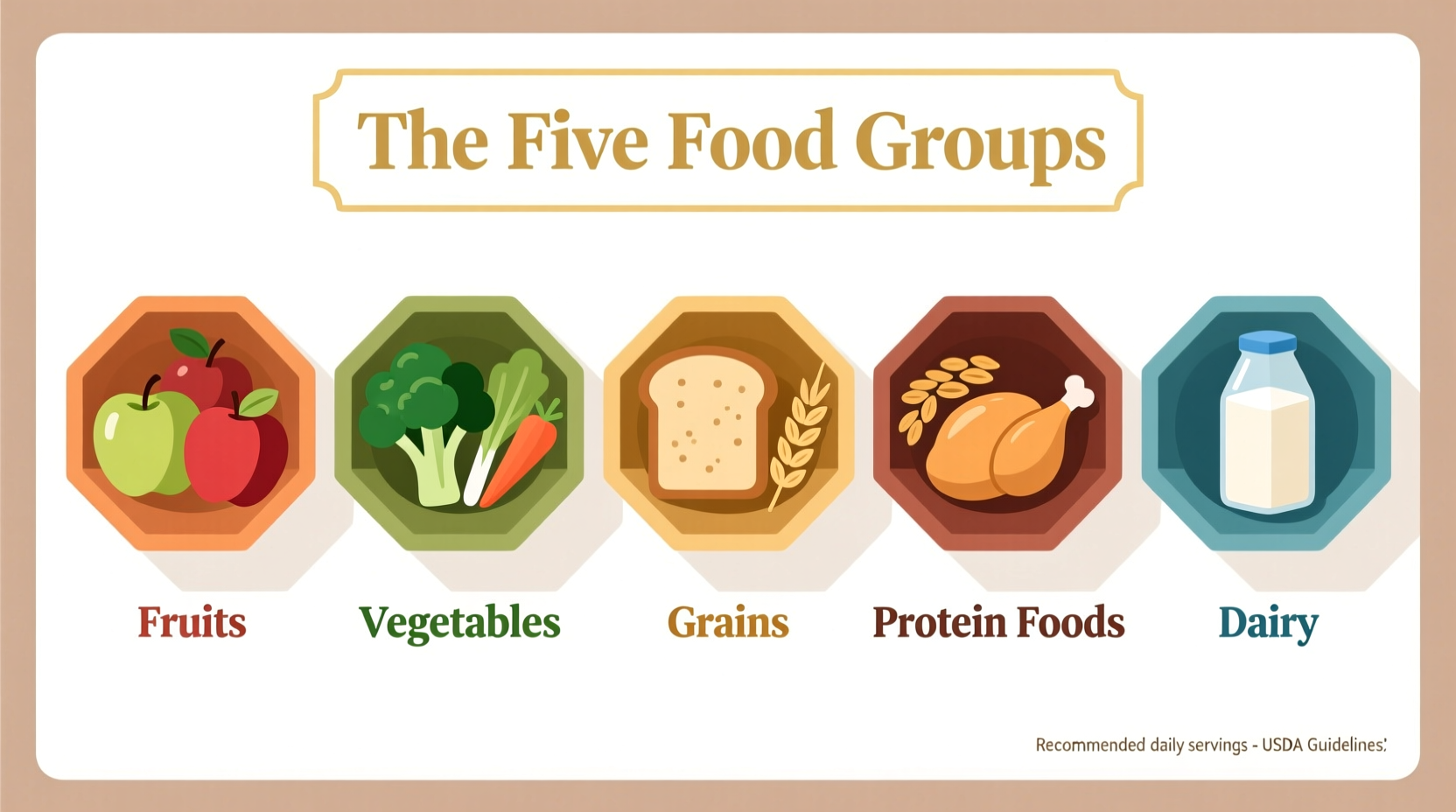Understanding the five food groups transforms how you approach meal planning and makes healthy eating surprisingly simple. Recent research shows that adults who consistently incorporate all five food groups into their daily meals experience 27% better nutrient intake and report higher energy levels throughout the day. Whether you're a busy parent, fitness enthusiast, or simply looking to improve your dietary habits, mastering these fundamental categories gives you the practical framework to make smarter food choices without complicated counting or restrictive diets.
Your Complete Guide to the Five Essential Food Groups
For decades, nutrition scientists have refined our understanding of how different foods contribute to human health. The current five-food-group system represents the culmination of extensive research into how specific food categories deliver unique nutritional benefits. Unlike fad diets that come and go, this evidence-based framework has stood the test of time because it focuses on food variety rather than restriction.
Fruits: Nature's Sweet Nutrient Powerhouses
Fruits provide essential vitamins, fiber, and natural antioxidants that support immune function and cellular health. The key is variety—different colored fruits offer different phytonutrients. While an apple a day keeps the doctor away, rotating through berries, citrus, melons, and tropical fruits ensures you get the full spectrum of benefits.
Many people don't realize that 100% fruit juice counts as part of your fruit intake, though whole fruits provide additional fiber. Aim for two cups of fruit daily, with at least half coming from whole fruits rather than juice. Frozen and canned fruits (without added sugar) are equally nutritious options when fresh produce isn't available.
Vegetables: The Colorful Foundation of Health
Vegetables deliver the widest range of nutrients across five subgroups: dark green (spinach, broccoli), red and orange (carrots, bell peppers), beans and peas (which also count as protein), starchy (potatoes, corn), and other vegetables (onions, mushrooms). Each subgroup provides unique health benefits.
Unfortunately, only 10% of Americans meet the daily vegetable recommendation of 2.5 cups. The solution? Incorporate vegetables into every meal—not just dinner. Try adding spinach to smoothies, bell peppers to omelets, or shredded carrots to pasta sauces. Roasting vegetables brings out natural sweetness that even picky eaters enjoy.
| Food Group | Daily Recommendation (Adults) | Key Nutrients | Smart Swaps |
|---|---|---|---|
| Fruits | 2 cups | Vitamin C, potassium, fiber | Whole fruit instead of juice |
| Vegetables | 2.5 cups | Vitamins A & K, folate, fiber | Dark leafy greens instead of iceberg lettuce |
| Grains | 6 ounce-equivalents | B vitamins, iron, fiber | Whole grains instead of refined |
| Protein Foods | 5.5 ounce-equivalents | Protein, iron, zinc, B vitamins | Plant proteins 3+ times weekly |
| Dairy | 3 cups | Calcium, vitamin D, potassium | Low-fat or fat-free options |

Grains: Beyond Basic Carbohydrates
Grains provide energy through carbohydrates but also deliver B vitamins and fiber crucial for digestive health. The critical distinction lies between whole grains (which contain all parts of the grain kernel) and refined grains (which have been stripped of nutrient-rich components).
At least half your grain intake should come from whole grains like brown rice, quinoa, oats, and whole-wheat bread. Surprisingly, many products labeled 'multigrain' or 'wheat' are still primarily refined grains. Check the ingredient list for 'whole' as the first ingredient to ensure you're getting the full nutritional package.
Protein Foods: More Than Just Meat
Protein foods encompass a diverse range including meat, poultry, seafood, eggs, nuts, seeds, and soy products. Beans and peas uniquely count in both the vegetable and protein groups. This category provides essential amino acids, iron, and zinc that support muscle maintenance and immune function.
While animal proteins are complete proteins (containing all essential amino acids), plant-based proteins can be combined throughout the day to achieve the same benefit. For example, rice and beans together form a complete protein profile. The Dietary Guidelines for Americans recommend including seafood at least twice weekly and varying protein sources to maximize nutrient diversity.
Dairy: Calcium-Rich Options for All Diets
Dairy foods provide calcium, vitamin D, and potassium essential for bone health and numerous bodily functions. The category includes milk, yogurt, cheese, and fortified plant-based alternatives like soy milk and yogurt.
Not everyone tolerates dairy well, but lactose-free options and fermented dairy products like yogurt often provide solutions. For those avoiding dairy entirely, choose fortified plant-based alternatives that provide comparable calcium and vitamin D levels. Remember that butter and cream have minimal calcium and don't count as dairy servings.
How Food Group Recommendations Have Evolved
Nutrition guidance has transformed significantly over the past century. Understanding this evolution helps you appreciate why current recommendations emphasize variety and balance:
- 1940s Basic Seven: The first official food groups included seven categories with specific serving recommendations, but lacked emphasis on variety within groups
- 1956 Basic Four: Simplified to milk, meat, fruits/vegetables, and bread/cereal—still missing important distinctions like whole vs. refined grains
- 1992 Food Pyramid: Introduced visual hierarchy but was criticized for overemphasizing carbohydrates and not distinguishing between healthy and unhealthy fats
- 2005 MyPyramid: Attempted to address previous shortcomings but was confusing with its vertical wedge design
- 2011 MyPlate: Current model using a place setting visualization that clearly shows half your plate should be fruits and vegetables
This progression reflects growing scientific understanding of how different foods interact with our biology. The current five-group system acknowledges that no single food provides all necessary nutrients, and that variety within each group matters as much as the groups themselves. As noted in the Dietary Guidelines for Americans 2020-2025, "a healthy dietary pattern is more than the food and beverages you eat—it's the combination of all the foods and beverages that make up your overall diet.\"
Practical Strategies for Daily Implementation
Knowing the five food groups is just the beginning—the real value comes from applying this knowledge daily. Start with these actionable strategies:
- Plate Mapping: Before eating, mentally divide your plate—fill half with fruits and vegetables, one-quarter with grains, and one-quarter with protein. Add a side of dairy.
- Color Challenge: Aim for three different colors of fruits and vegetables at each meal to ensure diverse phytonutrient intake.
- Whole Grain Swaps: Gradually replace refined grains with whole grains—one meal at a time to avoid overwhelming your palate.
- Protein Rotation: Create a weekly schedule that includes different protein sources to maximize nutrient diversity.
- Dairy Integration: Add plain yogurt to smoothies, include cheese in omelets, or enjoy milk with whole-grain cereal.
Meal planning becomes significantly easier when you think in terms of covering all five groups throughout your day rather than counting calories or macros. A balanced breakfast might include whole-grain toast (grains), scrambled eggs (protein), spinach (vegetables), and a glass of milk (dairy), with berries (fruit) on the side.
Frequently Asked Questions
What's the difference between the food groups and MyPlate?
The five food groups represent the nutritional categories, while MyPlate is the visual model showing how to proportion these groups on your plate. MyPlate recommends filling half your plate with fruits and vegetables, one-quarter with grains, and one-quarter with protein, plus a side of dairy.
Do beans count as both vegetables and protein?
Yes, beans and peas uniquely belong to both the vegetable group and protein foods group. When planning meals, count them in the group that helps you achieve better balance. If you've already met your vegetable needs, count them toward your protein requirement.
How do food group recommendations change with age?
Daily recommendations vary based on age, sex, and activity level. Children need smaller portions that gradually increase through adolescence. Older adults generally require fewer calories but similar nutrient density, so portion sizes decrease while emphasis on nutrient-rich foods within each group increases. The Dietary Guidelines provide specific recommendations for each life stage.
Can I be healthy following just four of the five food groups?
While possible short-term, consistently missing one food group creates nutritional gaps that can impact health over time. Each group provides unique nutrients difficult to obtain elsewhere. For example, eliminating dairy requires careful planning to get enough calcium and vitamin D from other sources. The most sustainable approach includes all five groups with appropriate substitutions when necessary.











 浙公网安备
33010002000092号
浙公网安备
33010002000092号 浙B2-20120091-4
浙B2-20120091-4